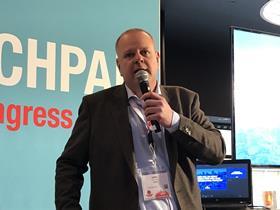
All growers in areas with low light levels will switch to LED lighting, the export manager of a leading greenhouse manufacturer has predicted.
Speaking at the inaugural Global Tomato Congress in Rotterdam, Henk van Tuijl of Kubo said LED lighting was “the future”, and he expects sales to increase rapidly in the coming years.
“People like to have vegetables available 365 days per year and in a big part of the planet the light in winter is just not enough to support the crop. In that case you need artificial lights, so lighting in greenhouses has a big future,” he told delegates.
However, he emphasised that, to date, sales of LED lights have been slowed by the fact that investments in greenhouse production tend to be based on return on investment.
“For quite some time LED lights have been disproportionately more expensive than traditional HPS lighting,” he said, “which means that so far not a lot of LEDs have been sold for greenhouses but that is changing quite rapidly.”
There are several reasons why sales are now beginning to rise, he believes, namely that the level of required investment has reduced; that knowledge is improving on the benefits of different coloured LEDs; and that there are parts of the world in which growers have almost no choice but to work with LEDs because the climate is too warm to use traditional HPS lighting which brings extra heat.
Looking to offer an extra level of control over the growing process, Dutch tech firm Hortikey has launched a fully automated forecasting tool called Plantalyzer, which general manager Andreas Hofland presented to delegates on the Launchpad stage.
The robot helps tomato growers estimate yield by autonomously measuring the size, quantity and ripeness of production in large-scale greenhouses, and the company has now implemented its first forecast system, with five more planned in 2020.
The robot allows growers to create yield maps of their entire greenhouse and by employing the data generated by daily scanning they can compile detailed forecasts predicting volume as well as quality.
“We deliver a harvest forecast for one, two, three and four weeks ahead of picking and we have calculated that growers should get a return on their investment within two years,” said Hofland.
Another greenhouse technology showcased at the event was climate screens, which are increasingly being used by growers to create a more homogenous climate and diffuse the light that enters the glasshouse.
Joost Haenen of Swedish manufacturer Ludvig Svensson told delegates how the company’s various screens can help producers achieve a more even spread of light and reduce shaded points and direct light. This helps reduce plant stress, speed up growth and produce healthier plants, Haenen said.



